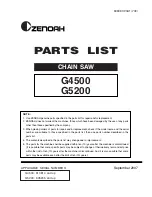
23
Let the chain saw work by producing a light leverage
pressure over the claw stopper. When sawing do not
press with strength.
Never work
−
with stretched arms
−
on hardly accessible places
−
standing on a ladder, a staging or a tree.
Never saw with the chain saw above shoulder height.
Do not overload the chain saw. You obtain best cutting
results when the chain speed does not fall.
Be careful at the end of a sawing cut. As far as the saw
leaves the wood the force of weight changes. There is
risk of accident for legs and feet.
Remove the chain saw only with running saw chain out
of the cut.
Never get in contact with the running saw with metallic
fences or the ground.
Switch off the chain saw between the cuts when
several cuts are carried out.
If the saw chain jams in the wood switch off
immediately the device and pull out the power plug.
Use a block to free the sword.
Make breaks when sawing so that the electric motor
can cool down.
Additional
advices
for
sawing
trunks
Never put the trunk for sawing on the ground. Support
the trunk in such manner that the cut does not close
and the saw chain jams. Use a safe base (e.g.
sawhorse). Avoid contact to ground with the sword pike
or saw chain.
Adapt shorter trunks before sawing and clamp them
firmly.
Avoid cutting of thin bosk and lumber. The chain saw is
not suitable for those works.
Carry out longitudinal cuts with special care as the claw
stopper is not used. Avoid saw backstroke by guiding
the saw with a small angle.
When working at a slope take always the position
above or on the side of the trunk or the lying sawing
material respectively. Pay attention to rolling trunks.
Additional
advices
for
sawing
timber under tension/release
If perches, trees or wood under tension become free of
tension by sawing extreme caution is demanded. The
sawing material can react completely uncontrolled and
result in heavy injuries or death.
Such works shall only be carried out by instructed
specialists.
For all works set always first of all on the pressure
side
the releasing cut and then the dividing cut
-
otherwise the chain saw can jam or strike back.
Wood on the upper side in tension
Place one cut (one third of the diameter of the trunk)
from the bottom up.
Then place a second cut on the same point from top
which cuts through the trunk.
Wood on the lower side in tension
Place one cut (one third of the diameter of the trunk)
from top to bottom.
Then place a second cut on the same point from
bottom which cuts through the trunk.
Strong trunks and strong tension
Place one cut (one third of the diameter of the trunk)
from buttom up.
Then place a second cut with distance to the first cut
from top which cuts through the trunk.
Cutting off of perches
Set 15 cm away from the trunk a cut from the bottom
up (one third of the trunk diameter).
Then place from top the second cut appr. 8 cm more
outside which cuts through the perch.
For removing the remaining part cut the perch close
to the trunk from bottom one third.
Place from top the second cut which removes the
remaining part.
Additional advices for chopping
down trees
Always wear a helmet in order to protect yourself
against perches falling down.
Pay attention to the length of the sword. Only those
trees shall be chopped down which have a trunk
diameter which is smaller than the length of the sword.
Before chopping down safeguard the working area.
Make sure that there are no persons or animals in the
fall area (minimum distance 2 tree lengths).
Make sure that the working area around the trunk is
free of risk to stumble and that you have an escape
route which is free of obstacles.
Provide for a safe standing position.
Hint:
Before chopping the tree decide on the chopping
direction. Consider in this case the balance point of the
treetop, neighbour trees, slope direction, state of health
of the tree and the wind direction. On this side the kerf
is cut in.
17
19
20
18
Summary of Contents for KS 2000-40 -
Page 3: ...2 1 2 3 4 5 6 7 8 ...
Page 4: ...3 9 10 11 12 13 14 15 16 ...
Page 155: ...154 ...
Page 156: ...155 ...
Page 157: ...156 ...
















































